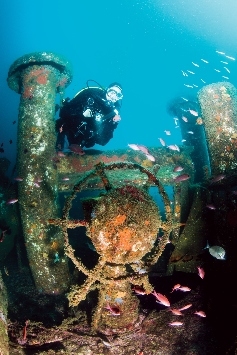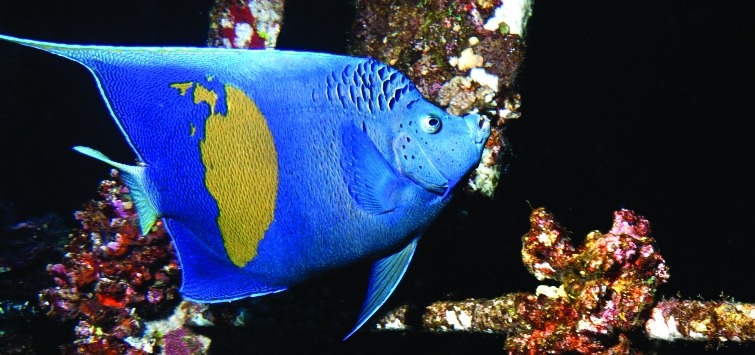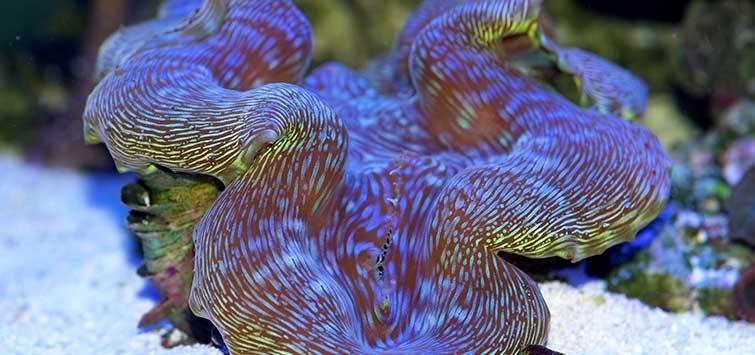Living Ghosts of the Sea: Reef Shipwreck Diving
It is a sad reality that shipwrecks have been a common occurrence since man took to ocean in the first seafaring crafts. Every coastal community on the planet can tell tales of epic adventure, men of courage against the awesome power of the raging sea, with the forces of nature often winning the hard-fought battle. These are powerful stories full of sorrow and unfathomable loss, of vessels foundered and dashed against rocks, and heroic efforts to save as many souls as possible amidst rough waves and terrible storms.
Sometimes it is not weather but rather human conflict, raging war fought on the high seas, that dispatches a vessel to the sea floor to become a maritime graveyard for its ill-fated crew. In more peaceful times, shipwrecks can be a more banal affair, stories of sheer incompetence—or the occasional insurance-fraud scheme—crashing crafts of wood and metal onto rocky reefs. And in recent years, some boats have been sunk purposefully for more altruistic reasons, such as for shipwreck diving and marine life, with ships purposefully sunk to the bottom of the ocean to become artificial oases of reef life in otherwise barren surroundings.
Countless books and unmeasurable bytes of data have been written and generated about wreck exploration, treasure seeking, maritime archaeology, the thrill of discovery, and finding the final resting places of fallen seafarers. But this is a tale of a different kind of sunken treasure, not of man but of the marine life that colonizes shipwrecks, creating new artificial reef habitats from all those rusty hulks of metal.
We’ll begin our tale at as good a starting point as any, with a look at one of the planet’s oldest known famous shipwrecks.
The Peristera Wreck

Iron and steel hold up quite well in the ocean, considering how corrosive seawater can be; what doesn’t last, except in relatively rare anoxic conditions, is timber, which means the world’s most ancient wrecks are known not from their structure but from their cargo. In this case, it was a hull full of wine-carrying amphorae, the handled clay storage jugs of Greek and Roman antiquity.
The Peristera Wreck, as it has become known, lies off the Greek island of Alonnisos, and it is one of the best-preserved shipwrecks of the Classical period. We know next to nothing about it other than that it sank somewhere around the end of the 5th century BCE and seems to have gone down gently. Much still remains to be learned, however. The estimated 4,000 amphorae provide a varied substrate for sponges, tube-dwelling worms, and countless fishes. They are covered in life and remind me of some of my earliest attempts at breeding cichlids in tanks with several terracotta pots.
What the Peristera wreck shows us is that the addition of some structural diversity to the sea floor creates opportunities for species to colonize and, in effect, set up home. What more modern shipwrecks offer is even greater. Not only do they provide a new habitat ripe for colonization, but they also provide several entirely different habitats, often very close together and within a very small footprint.
Ghostly Wrecks, Full of Life
Another Mediterranean wreck from more recent times, lying off the Catalonia coast, is an old freighter of little historical note that I’ve explored where it sits in shallow water. Her upper superstructure offers refuge for damselfish and occasional shoals of barracuda, and her decks support a turf of algae full of encrusting life and grazing nudibranchs. A few inches below one rich section of habitat are the ships’ companionways, bathed in nutrient-rich currents and almost entirely dark. These are home to Anthias anthias, the type specimen that gave its name to so many other fishes.Cave-like environments are common on wrecks, but the greatest concentration of life is usually where currents are highest and one habitat borders another. The deep interior parts of wrecks are often silty, rusty, and risky places that attract hardier divers than me.
Exploring these ghostly holds, passageways, and engine rooms is, for some, an obsession. I prefer to look in from the outside, but it can be fascinating and a little thrilling, especially at night, to go further. What appear to be empty structures can come alive with invertebrates. If I don’t have enough crustacean photos on my memory card, a night dive on a wreck with a macro lens will usually sort that out. Hermit and boxer shrimp are reliable subjects, especially in the Red Sea.
Can the rusty steel of a shipwreck inspire your own marine or reef aquascaping? Possibly, but you’ll need aquarium-safe materials. You might cast lengths of cement or even shape paving slabs to create shapes that resemble the lengths of metal that are so integral to these artificial reef habitats. You might also consider learning from where fish congregate along passageways of shipwrecks, and use this knowledge to provide shaded areas where overhangs or restricted lighting mimic those conditions.
Just about any wreck can lend a shady spot. I came across an old wheelhouse on an amazing wreck in the Indian Ocean. Purposefully sunk to help the local dive centers, she sits on a plateau of sand—interesting in its own way before the sinking, with the occasional patch of garden eels—but with the addition of the shipwreck, the overall biodiversity of the area has risen enormously.
The wheelhouse is little bigger than a public telephone booth and is a gloomy place until flashguns fire and it is revealed to be full of Tubastraea sun polyps, with schools of soldierfish resting up until they disperse to feed at night.
Not all wrecks I’ve been lucky enough to explore are in the warm waters of the tropics. Off the stormy UK coast, some are so broken up that little remains other than steel plates, maybe with the odd boiler or propeller cast off to one side or another. Even so, they may be covered in life and, despite the stormy and silt-laden waters, surprising oases of life can be found.
The SS Carnatic and Djabeda

This wreck and others like it give corals and encrusting life the chance to colonize and beat their neighbors to the prize of light and current. I found a lifeboat davit sticking far out into a strong current, heavily colonized by photosynthetic coral life. I suspect that this structure would hold a lot more coral if the currents were lower and perhaps divers were more careful with their fin kicks, as there was a small rubble zone forming beneath it.
This wreck was a particularly fine example, with several different habitats in close proximity. On the foredeck I found a frogfish sheltering under what remains of a deck winch, which has become colonized by sponges thriving in the high current.
Another famous shipwreck where multiple habitats are separated by just a thin layer of steel is the Djabeda off Mauritius’ northernmost point. It was also sunk for the benefit of the diving industry, and shipwreck divers can fin across her deck to her high-current foremast area and then shelter against her hull, where openings have been cut to allow for exploration.
The Shipyard and Ulysses
The Djabeda is pretty, but perhaps the prettiest of all the Indian Ocean wrecks is the Shipyard in the Maldives. This apparently uninspiring wreck—it’s not a great name after all—comprises two small hulks related to the tuna industry that rest on the seafloor, one almost at a right angle against the atoll side and the other a little deeper. This truly is an exceptional dive site. The vessels are cloaked in Tubastraea, including huge sprays of the black variety, clearly thriving in the current. Slowly, but remorselessly, the two old hulks are losing their identity. As the coral mass grows, there is less and less of the ship, the reef’s framework, visible.
At some point in the far, far future, these vessels will be puzzling iron-rich layers in limestone hills. What does a wreck look like years after the corals have taken over?
Perhaps there’ll be a time when all the wrecks we know today are entirely obscured by coral and have collapsed into rusty rubble. Indeed, access to many increasingly fragile wreck interiors is discouraged or limited by those responsible for divers’ safety.
Today, we see many vessels slowly succumbing and losing their identity. Looking at the Ulysses in the Red Sea is a study in how much coral can grow in the shallows—in this case, since 1887. More recent wrecks, sunk within many of our lifetimes, are still very recognizable, though slowly but surely the weight of coral and sometimes, it must be said, damage from divers and dive boats mooring badly and dragging anchors speeds their decay.
From Wrecks to Reefs
Ultimately nothing much can be done to save these wrecks, of course, beyond asking boaters and divers to take care around them. But in terms of colonization by reef life, perhaps we should simply enjoy watching the processes of sea life carry on—rejoice as wrecks become reefs, with the last traces of keels and hulls slowly turning into unrecognizable mounds on the seafloor.
One thing is clear: we should keep on cleaning up decommissioned seagoing vessels and safely sinking them for the benefit of future generations. It is surely a good thing that the majority of ships sunk today are sent to the bottom out of such altruistic notions, and I am glad to see some municipalities and organizations cutting out the middleman and purposefully sinking structures to become artificial reefs.
These efforts range from New York City’s mass sinking of 2,500 stripped-down subway cars off the eastern seaboard of the United States, where they have become colonized by fish and coral life, to more targeted programs like the BioRock project off Permutan, Bali, where rebar structures were purpose-built in the shallows and seeded with corals to delight vacationing divers and snorkelers with thriving manmade reefs in areas where corals had previously been in decline.
I’ve encountered my share of these structures through shipwreck diving, engineered, created, and sunken to the seafloor to offer shelter and structure that marine life can colonize and utilize. It is a wonderful and positive human response to the tragedy of coral reefs in distress and decline around the world, a way to give reef creatures new life on and among our relics.
See the full article on TFH Digital
https://www.tfhdigital.com/tfh/mar_apr_2021/MobilePagedReplica.action?pm=2&folio=66#pg69

.png?h=595&iar=0&w=2781&hash=5FD5E69473BCC22199FBFA2FB71B6033)



